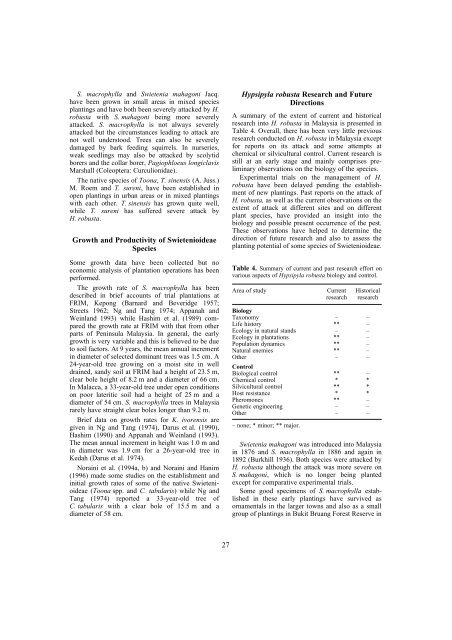Hypsipyla Shoot Borers of Meliaceae in Sri Lanka - Australian ...
Hypsipyla Shoot Borers of Meliaceae in Sri Lanka - Australian ...
Hypsipyla Shoot Borers of Meliaceae in Sri Lanka - Australian ...
Create successful ePaper yourself
Turn your PDF publications into a flip-book with our unique Google optimized e-Paper software.
S. macrophylla and Swietenia mahagoni Jacq.<br />
have been grown <strong>in</strong> small areas <strong>in</strong> mixed species<br />
plant<strong>in</strong>gs and have both been severely attacked by H.<br />
robusta with S. mahagoni be<strong>in</strong>g more severely<br />
attacked. S. macrophylla is not always severely<br />
attacked but the circumstances lead<strong>in</strong>g to attack are<br />
not well understood. Trees can also be severely<br />
damaged by bark feed<strong>in</strong>g squirrels. In nurseries,<br />
weak seedl<strong>in</strong>gs may also be attacked by scolytid<br />
borers and the collar borer, Pagiophloeus longiclavis<br />
Marshall (Coleoptera: Curculionidae).<br />
The native species <strong>of</strong> Toona, T. s<strong>in</strong>ensis (A. Juss.)<br />
M. Roem and T. sureni, have been established <strong>in</strong><br />
open plant<strong>in</strong>gs <strong>in</strong> urban areas or <strong>in</strong> mixed plant<strong>in</strong>gs<br />
with each other. T. s<strong>in</strong>ensis has grown quite well,<br />
while T. sureni has suffered severe attack by<br />
H. robusta.<br />
Growth and Productivity <strong>of</strong> Swietenioideae<br />
Species<br />
Some growth data have been collected but no<br />
economic analysis <strong>of</strong> plantation operations has been<br />
performed.<br />
The growth rate <strong>of</strong> S. macrophylla has been<br />
described <strong>in</strong> brief accounts <strong>of</strong> trial plantations at<br />
FRIM, Kepong (Barnard and Beveridge 1957;<br />
Streets 1962; Ng and Tang 1974; Appanah and<br />
We<strong>in</strong>land 1993) while Hashim et al. (1989) compared<br />
the growth rate at FRIM with that from other<br />
parts <strong>of</strong> Pen<strong>in</strong>sula Malaysia. In general, the early<br />
growth is very variable and this is believed to be due<br />
to soil factors. At 9 years, the mean annual <strong>in</strong>crement<br />
<strong>in</strong> diameter <strong>of</strong> selected dom<strong>in</strong>ant trees was 1.5 cm. A<br />
24-year-old tree grow<strong>in</strong>g on a moist site <strong>in</strong> well<br />
dra<strong>in</strong>ed, sandy soil at FRIM had a height <strong>of</strong> 23.5 m,<br />
clear bole height <strong>of</strong> 8.2 m and a diameter <strong>of</strong> 66 cm.<br />
In Malacca, a 33-year-old tree under open conditions<br />
on poor lateritic soil had a height <strong>of</strong> 25 m and a<br />
diameter <strong>of</strong> 54 cm. S. macrophylla trees <strong>in</strong> Malaysia<br />
rarely have straight clear boles longer than 9.2 m.<br />
Brief data on growth rates for K. ivorensis are<br />
given <strong>in</strong> Ng and Tang (1974), Darus et al. (1990),<br />
Hashim (1990) and Appanah and We<strong>in</strong>land (1993).<br />
The mean annual <strong>in</strong>crement <strong>in</strong> height was 1.0 m and<br />
<strong>in</strong> diameter was 1.9 cm for a 26-year-old tree <strong>in</strong><br />
Kedah (Darus et al. 1974).<br />
Nora<strong>in</strong>i et al. (1994a, b) and Nora<strong>in</strong>i and Hanim<br />
(1996) made some studies on the establishment and<br />
<strong>in</strong>itial growth rates <strong>of</strong> some <strong>of</strong> the native Swietenioideae<br />
(Toona spp. and C. tabularis) while Ng and<br />
Tang (1974) reported a 33-year-old tree <strong>of</strong><br />
C. tabularis with a clear bole <strong>of</strong> 15.5 m and a<br />
diameter <strong>of</strong> 58 cm.<br />
27<br />
<strong>Hypsipyla</strong> robusta Research and Future<br />
Directions<br />
A summary <strong>of</strong> the extent <strong>of</strong> current and historical<br />
research <strong>in</strong>to H. robusta <strong>in</strong> Malaysia is presented <strong>in</strong><br />
Table 4. Overall, there has been very little previous<br />
research conducted on H. robusta <strong>in</strong> Malaysia except<br />
for reports on its attack and some attempts at<br />
chemical or silvicultural control. Current research is<br />
still at an early stage and ma<strong>in</strong>ly comprises prelim<strong>in</strong>ary<br />
observations on the biology <strong>of</strong> the species.<br />
Experimental trials on the management <strong>of</strong> H.<br />
robusta have been delayed pend<strong>in</strong>g the establishment<br />
<strong>of</strong> new plant<strong>in</strong>gs. Past reports on the attack <strong>of</strong><br />
H. robusta, as well as the current observations on the<br />
extent <strong>of</strong> attack at different sites and on different<br />
plant species, have provided an <strong>in</strong>sight <strong>in</strong>to the<br />
biology and possible present occurrence <strong>of</strong> the pest.<br />
These observations have helped to determ<strong>in</strong>e the<br />
direction <strong>of</strong> future research and also to assess the<br />
plant<strong>in</strong>g potential <strong>of</strong> some species <strong>of</strong> Swietenioideae.<br />
Table 4. Summary <strong>of</strong> current and past research effort on<br />
various aspects <strong>of</strong> <strong>Hypsipyla</strong> robusta biology and control.<br />
Area <strong>of</strong> study Current<br />
research<br />
– none; * m<strong>in</strong>or; ** major.<br />
Historical<br />
research<br />
Biology<br />
Taxonomy – –<br />
Life history ** –<br />
Ecology <strong>in</strong> natural stands – –<br />
Ecology <strong>in</strong> plantations ** –<br />
Population dynamics ** –<br />
Natural enemies ** –<br />
Other<br />
Control<br />
– –<br />
Biological control ** –<br />
Chemical control * *<br />
Silvicultural control ** *<br />
Host resistance * *<br />
Pheromones ** –<br />
Genetic eng<strong>in</strong>eer<strong>in</strong>g – –<br />
Other – –<br />
Swietenia mahagoni was <strong>in</strong>troduced <strong>in</strong>to Malaysia<br />
<strong>in</strong> 1876 and S. macrophylla <strong>in</strong> 1886 and aga<strong>in</strong> <strong>in</strong><br />
1892 (Burkhill 1936). Both species were attacked by<br />
H. robusta although the attack was more severe on<br />
S. mahagoni, which is no longer be<strong>in</strong>g planted<br />
except for comparative experimental trials.<br />
Some good specimens <strong>of</strong> S. macrophylla established<br />
<strong>in</strong> these early plant<strong>in</strong>gs have survived as<br />
ornamentals <strong>in</strong> the larger towns and also as a small<br />
group <strong>of</strong> plant<strong>in</strong>gs <strong>in</strong> Bukit Bruang Forest Reserve <strong>in</strong>

















